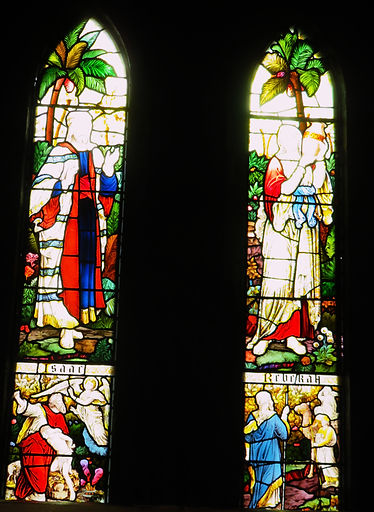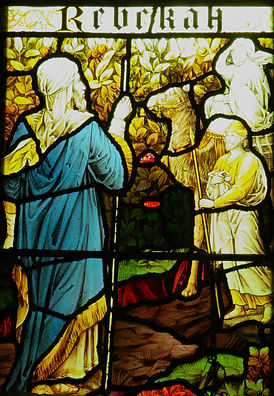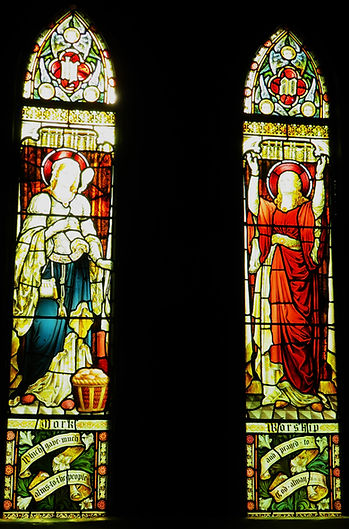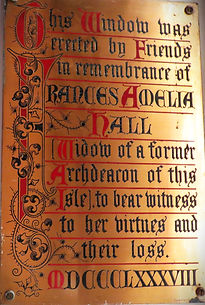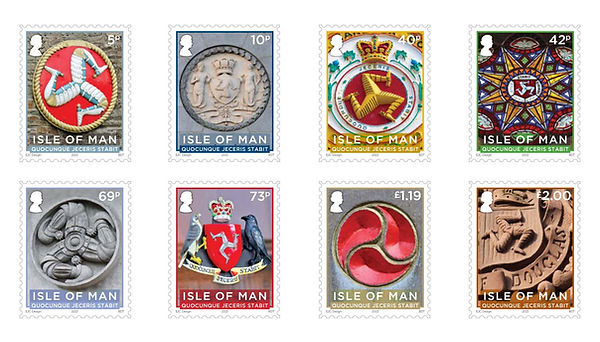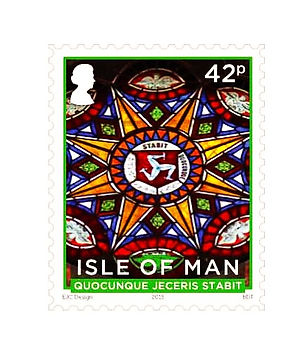The Stained Glass Windows

The magnificent three part memorial window dominates the East wall of the church. The centre section measure 32 feet by 3 feet (9.75m by 91cm) whilst the two side lights each measure 24 feet by 2 feet (7.32m by 0.61m). The original coloured glass window was replaced by the beautiful stained glass window we see today in 1927 and was erected by the children of William and Emma Clegg. The stained glass is the work of Messrs. Jones and Willis, a Birmingham firm established in 1847 who later opened premises in London and Liverpool.
Mr. W. Clegg
F.R.C.O.
(Church
Organist)


Lower Section
At the centre of the lower section is the figure of St. Thomas the Apostle who is Patron Saint of the church. He is depicted wearing brown robes. The figures on the left and right represent music in worship with the harp and organ finding a place in this representation.

Cental Images

The central image is of Jesus Christ on the cross in a setting of golden light. At the foot of the cross stand the Virgin Mary and St. John. To the left is the scene of the Nativity whilst on the right the Resurrection is suggested by the tomb and watching Roman soldiers. Surmounting this is the risen Christ with a pierced hand uplifted in blessing recalling the scene of the Ascension. The over all theme is "Christ in Glory" - the Alpha and Omega - the Beginning and the End.





At the base of the window is the inscription,"To the glory of God and in loving memory of their parents, Emma Clegg who died 10th Nov 1908 and William Clegg who died 30th Sept 1922, this window was erected by their children Easter 1927."
The inscription on the cross above the crucified Christ is represented by the initial letters of the translation in Latin I N R I (Iesus Nazarenus Rex Iudaeorum) Jesus of Nazareth, King of the Jews.



These three images show more of the detail of the Memorial Window.
Left - The harpist from the left side light.
Centre - The ascending angel above Christ on the cross.
Above - The window above the central panel
North Wall Windows
The Children's Window

This window was unveiled on 10th September 1892 and was called, "The Children's Window" because the money for it had been given by the children attending the Church Service on the afternoons of the first Sunday of each month. The subject is the ministry of Angels and the first light is a copy of a piece of sculpture by Canon Coll (German). In just five years the children's offerings paid for the window (£56), the brass tablet (£5) and a new alms dish (£4). They also paid for two brass vases and flower holders for the Holy Table and an oak Glastonbury Chair.




Close up detail of the left and right window lights and the carving on the Glastonbury Chair.

The Rev. Hutton Window




To the immediate right of Children's Window is the window dedicated to the memory of Rev. F. P. B. Hutton M.A. who was the incumbent at St. Thomas' between 1872 and 1877. The Rev Hutton died in Leicester on 22nd October 1884. The money to pay for the window was raised by a group of parishioners.
The window depicts Jesus during childhood and with children. The light to the left depicts Mary, Joseph and the young Christ who is sawing a piece of wood whilst Mary and Joseph look on lovingly - "Is not this the carpenter, the son of Mary" (Mark Chapter 6 - verse 3)
The right light depicts Jesus with a group of children - "Suffer little children...to come unto me, for of such is the Kingdom of Heaven". (Matthew Chapter 19 - verse 14)
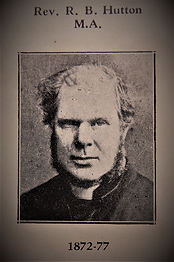
The Garrett / Musicians' Window



To the immediate right of the Hutton window is the window dedicated to Philip Louis Garrett who was the organist at St. Thomas' for many years. Garrett was born 17th April 1824 and died on 25th July 1880. The window was erected in his memory by J. Royston.
The main theme of the window is music and musicians which clearly reflects Garrett's love for the subject.
The left hand light depicts Jubal who was a descendant of Cain. According to the account in Genesis Jubal is the father of those who play the harp and flute. Some descriptions include the lyre, organ and all musicians. "...His brother's name was Jubal; he was the ancestor of those who play the harp and pipe" (Genesis Chapter 4 verse 21.)
The right hand light depicts King David playing the harp / lyre (Hebrew Kinnor). In the book of Samuel David is a young shepherd who gained fame first as a musician and later by killing the enemy champion Goliath. "...David would take his lyre and play it so that relief would come to Saul; he would recover and the evil spirit would leave him alone". (Samuel 1 Chapter 16 verse 23)

The Memorial Chapel Window



The final window on the north wall is in what is now the Memorial Chapel. It is dedicated to Lieutenant Colonel Shum who was one of the first church wardens at St Thomas'. His wife and children all predeceased him and he is buried in St. George's churchyard.
The image on the left light depicts the referenced verses from St. John's Gospel, "...so saying she went to call her sister Mary and, taking her aside, said, 'The Master is here and is asking for you.' As soon as she heard this she rose and went to him." (John Chapter 11 verses 28 & 29). The lower panel reads, "Blessed are they that mourn for they shall be comforted."
The image on the right light depicts another referenced verse from St. John's gospel, "When Jesus saw Nathanael coming towards him, he said, 'Here is an Israelite worthy of the name; there is nothing false in him'." (John Chapter 1 verse 47). Nathanael is also known as Bartholomew - Nathanael Bar-Tolmei or Nathanael son of Tolmei. The lower panel reads, "Blessed are the pure in heart for they shall see God."
A report in the Isle of Man Times from 27th September 1873 reads as follows.
"This week two coloured glass windows have been placed in St. Thomas's Church, Douglas, in memory of the late Colonel Shum, who was one of the first trustees of the church. They have been presented to St. Thomas's by Robert Shum Esq., of London, a nephew of the late colonel. The designs on the windows, which are exquisitely coloured, represent two interesting scriptural subjects.
The work erecting them in the church was entrusted to Mr. C. Thomson, plumber & co. of Strand Street."



South Wall Windows
The Boardman Window



The first window we come to on the south side of the church as we move forward from the main entrance is dedicated to then memory of Robert and Jane Boardman. It was given by their daughter Jane Dalby in 1888.
The left light has an image of Ruth holding ears of corn. The lower panel reads, "She gleaned in the field after the reapers. Ruth is the person after whom the Old Testament book of Ruth is named. She was not an Israelite but came from Moab and is named in the gospel according to St. Matthew as an ancestor of Jesus. "...Salmon of Boaz (his mother was Rahab), Boaz of Obed (his mother was Ruth), Obed of Jesse; and Jesse was the father of King David." (Matthew Chapter 1 Verses 5 & 6).
She is depicted holding ears of corn as a symbol relating to her story in the book of Ruth. "Ruth gleaned in the field until evening. When she threshed out what she had gathered she ended up with nearly a full sack of barley." (Ruth Chapter 2 Verse 17).
The right hand light depicts Martha of Bethany holding a bowl of fruit. She was a sister of Lazarus whom Jesus brought back from the dead. Martha was also a sister of Mary Magdalene. The lower panel reads, "There they made Him a supper and Martha served.". This relates to the story in the Gospel according to John. "They gave a super in His honour, at which Martha served and Lazarus was among the guests with Jesus." (John Chapter 12 Verse 2).
A report in the Isle of Man Times from 13th November 1897 reads.
"Last week a very fine stained glass window was placed in St. Thomas's Church, Douglas at a cost of nearly £70 which was defrayed by money left by the late Mrs Dalby who previously presented two other windows. The new window is in the South aisle nearest the West door.
The subjects of the design are Martha and Ruth, two scriptural characters of whom Mrs Dalby had expressed a great regard and she made an instruction in her will that Martha and Ruth be the subjects for illustration. The installation of this window completes the set of eight, four on each of the North and South walls.
The design and manufacture of the window is by Messrs. Heaton, Butler and Bayne, of London and was installed by Mr Nicholson and Mr Royston of Douglas.
The brass plaque was made by Gawthorn, of Long Acre, London."
The James Dalby Window


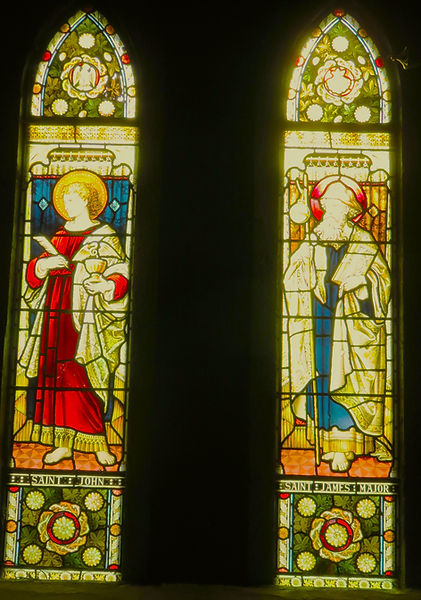
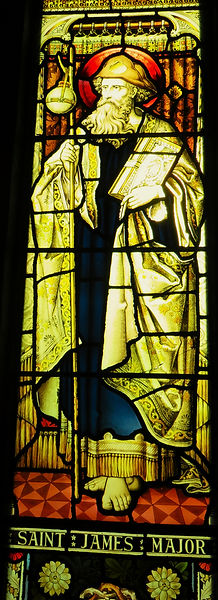
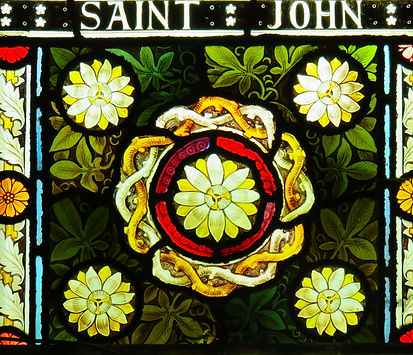
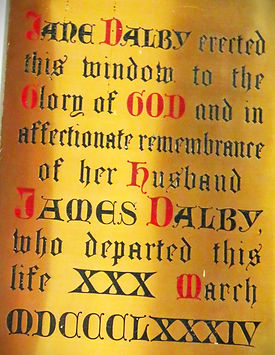

Next to the Boardman Window on the South Wall of the church is the stained glass window dedicated to the memory of James Dalby who died on March 30th 1884. The window was erected in "affectionate remembrance" by his widow, Jane Dalby who was Robert Boardman's daughter. Jane Dalby died on 21st September 1896 at Windsor Cottage, Douglas.
The Isle of Man Times dated 19th May 1888 caries the headline, "Presentation to St. Thomas'Church" and goes into some detail about the presentation of the window.
"A handsome Stained Glass Window has been placed in one of the stone window frames in the South aisle of St. Thomas'Church. It is the gift of Mrs Dalby of Windsor Road and has been thoughtfully erected by her in memory of her deceased husband, Mr James Dalby.
The window consists of two panes, each being formed of three panels. In the centre panel of one of the panes, St. John the Evangelist is depicted, in his hands the saint holds the emblems which are usually associated with him. In his right hand he holds a pen which, in Ecclesiastical heraldry, signifies that he is the inspired author of Holy Writ. In the upper panel is the figure of an eagle, another emblem of St John, surrounded by passion flowers and beautifully shaded foliage. The bottom panel is also exquisitely stained with flowers and foliage.
In the other panel St. James the Greater is depicted. The saint's face is the picture of majesty, and the hair and beard are admirably shown. In the right hand is the pen which stamps him as the author of a portion of scripture whilst in the left hand he holds the pilgrim's staff on which is slung a water bottle. On the head covering is shown the shell that denotes the pilgrim...the work reflects credit upon the artists, Messrs Heaton, Butler and Bayne of Garrick Street, London. The window has been fitted by Messrs Royston and Sons, stone cutters, and Messrs Nicholson Brothers, glaziers, both of Douglas.
The situation of the window is most appropriate being immediately opposite to the pew wherein Mr Dalby worshipped. The generous donor, it is said, contemplates the presentation of another window in memory of her decease parents, so struck is she with the beauty of the present one". N.B. This is the Boardman window as described above.
St. James the Greater or James Major is given these names to distinguish him from the other disciple, James Minor or James the Less. Greater meaning older or taller rather than more important.
On the wall beside the window is a brass plaque with the wording, " Jane Dalby erected this window to the Glory of God and in affectionate memory of her husband James Dalby who departed this life XXX March MDCCCLXXXIV".
Matthew Ch 4 Vs 21-22 "Going further on, He saw another pair of brothers, James son of Zebedee and his brother John; they were in a boat with their father Zebedee, mending their nets. He called them and at once they left the boat and their father, and followed Him".
The Jane Dalby Window
Next to the James Dalby window on the South wall of the church is the window dedicated to the memory of Jane Dalby, the daughter of Robert and Jane Boardman and widow of James Dalby.
The window depicts Isaac and Rebecca with the lower panels illustrating Abraham offering up Isaac in sacrifice and Rebecca meeting Isaac in the desert.
The design work for the windows is credited to the Rev. Savage the then vicar of St. Thomas'. The manufacturer was Messrs Heaton, Butler and Payne of Garrick Street, London WC and the installation was undertaken by the local, Douglas firms of Messrs Royston and Sons (stonework) and Nicholson Bros (glazing).
There were several newspaper reports of the unveiling of the windows and one of the most comprehensive was in The Manx Sun of December 8th 1888 which had the headline "The Memorial Windows at St. Thomas' Church" along with the sub-heading "Unveiling by the bishop: His Lordship on the question of church decoration: Interesting Speeches".
The lengthy article begins:
"Yesterday forenoon (7th December 1888) the two stained glass windows recently placed in the south wall of St. Thomas' Church, Douglas were unveiled... by the Lord Bishop of the Diocese (John Bardsley)"
The report goes on to state that the bishop denounced puritan ideals that a church could not be too plain and cited the poet John Milton (1608 - 1674)) who raised his voice in defence of church decoration with the bishop speaking of those who love the "high embowed roof" such as this church possesses", and the organ "... of which you may well be proud". He added that "...it is a privelge for me, as chief minister of the church in the Isle of Man, to come here this morning".
The bishop's references to the roof and organ relate to Milton's 1631 poem, Il Peneroso (The Thinker), from which the bishop quoted the following lines:
"Love the high embowed roof
With antique pillars massy proof
And storied windows richly dight (adorned)
Casting a dim religious light
There let the pealing organ blow
To full voiced quires (sic) below
In service high and anthems clear"
He went on to explain that St. Thomas' has "..., the high embowed roof and you have pillars which although they don't look "massy", yet nevertheless, coming from the limestone, may well be called antique. But you have lacked one feature..."storied windows richly dight, casting a dim religious light"... and now by the pious liberty of friends that want has now been supplied".
The Frances Amelia Hall Window
The final window on the South wall is dedicated to Frances Amelia Hall, widow of the former Archdeacon, the Venerable John Cecil Hall. Frances was the eldest daughter of the Hon. John Wingfield - Stratford and a cousin of Viscount Powerscourt of Wexford, County Wicklow, Ireland . She married Cecil Hall on February 8th 1832 at St. Mary-le-Bone, Middlesex. Hall became the Archdeacon of the diocese of Sodor and Man in 1839 and died of Typhus in Andreas, Isle of Man in 1844.
An article in the Mona's Herald on Wednesday 5th December 1888 states that, "...Mrs. Cecil Hall, a constant and devoted worshipper at this church (St. Thomas') during her lifetime, whose death was deeply lamented on every hand. The memorial has been willingly subscribed for by those who valued her good work and are conscious of her many generous acts of kindness. The subject of this window is highly interesting and appropriate, containing as it does two symbolical figures representing work and worship."
The window was designed by Rev. Savage, manufactured by Messrs. Heaton, Butler and Payne, Garrick Street, London WC. and fitted by Messrs. Royston ad Son (stonework) and Messrs. Nicholson Brothers, Well Road, Douglas (glazing). It was unveiled by the Bishop of Sodor and Man, John Bardsley, on Friday 7th December 1888. In a full and very lengthy report about the unveiling of the window in the Mona's Herald on Wednesday 12th December 1888 the bishop is reported to have said, "... she (Mrs. Hall) did not content herself, as some rich people do, simply with being almoner of the wealth, but gave liberally of her time and of her energies in teaching the young, and in every way promoting the honour and glory of God...It is, then, on behalf of of the subscribers, of whon I count it a privilege to number myself as one, that I this morning dedicate this window," to the glory of God, for the adorning of this church, and in honoured memory of Frances Amelia Hall".... At the ceremony 68 boys from Douglas Grammar School, which was founded by Mrs Hall, attended with four masters.
Another article in the Manx Sun about the unveiling of the window on Saturday 8th December 1888 goes into some detail about Cecil Hall's death and Amelia's decision to remain on the Island as a widow.
"... Archdeacon Hall, at a time when the north part of this Island was visited with a terrible epidemic (Typhus) laid down his life in the discharge of his pastoral duty. After his death his widow did not return home to England... she regarded it as her duty to remain here on this Island, and to discharge her duty best by continuing to devote, not only her money, but her time and her energies, to the service of God's house in this Island.".
The two panels in the window depict Work and Worship. The left panel (work) show a female in medieval costume engaged in spinning from a distaff. In the bottom right corner is a basket of bread and a bottle of wine. The right hand panel shows a female in the attitude of supplication.
Beneath the two panels is a scroll which reads, "Which gave much alms to the people, and prayed to God alway - Acts X., 2.
The Brass plaque is inscribe, "This window was erected by friends in remembrance of Frances Amelia Hall widow of a former Archdeacon of this Isle to ber witness to her virtues and their loss MDCCCLXXXVIII" (1888)
The Rose Window
The beautiful Rose Window which sits high on the west gable wall of the church is the oldest of our stained glass windows. It was installed in 1850, just one year after the church was opened.
It was designed by Philip Moore of Douglas and manufactured by John M'weeny (sic) of Dublin. The window was paid for from monies donated by Miss. F. Garton.
The Manx Sun of July 20th 1850 printed the following short report of the window's installation...
St. Thomas's Church.
"We invite the attention of our readers to a beautiful rose window of stained glass which has just been inserted in the western gable of St. Thomas's Church. The execution of this work of art reflects great credit on Mr M'weeny, of Marlborough-Street, Dublin. The design was drawn by the late Philip Moore, of Shaw's Brow, in this town; it consists of the arms of Mann on a ruby ground in the centre of a star encircled by heads of Cherubim. We understand that the whole cost has been defrayed out of the proceeds of a beautiful hymn, composed and publish by Miss F. Garston, the talented lady by whose exertion a considerable sum of money was raised towards the erection of this beautiful Church. We have only to say in conclusion to our fair readers that they can "go and do likewise."
We are glad to see workmen employed in raising the bell tower of the church; and hope that the spire will be proceeded with according to the design of the architect.
Some trifling debt upon this sacred edifice still remains, which it is hoped the collection advertised for to-morrow (sic) will entirely remove".
N.B. The spire mentioned in the article was never erected.
An earlier newspaper report stated that the sum of £17. 14s was donated to St. Thomas' building fund by Miss F. Garston of Cheshire.
John M'weeny / John McWeeney.
Thom's Almanac and Official Directory of Dublin in 1862 has the following listing for "10 Marlborough Street Dublin, "M'Weeny. Jn. Stained glass and patent sash works, and zinc and lead works".
Shaw's Pictorial Directory of 1850 lists, "John McWeeney 9 -10 Marlborough Street and that Edward Lowe was at 13 Marlborough Street". It appears that McWeeney took over part of Lowe's business when Lowe became ill and was losing his sight. Lowe had won a silver medal for a stained glass window at the Royal Dublin Society Exhibition in 1847. Lowe's stained glass windows are fairly numerous throughout Ireland.
Isle of Man Post Office 3 legs (Triskelion) stamp Issue.
The Rose Wind featured on the Isle of Man Post Offices' 2013 Triskelion stamp issue. The series of 8 stamps features different depictions of the three legs symbol. The stamp values ranged from 5p to £2.00 with the Rose Window featuring on the 42p stamp which was the price of the standard letter rate at that time.
